Unit 2 Ways to go to school 复习课件(词组+句型+语法+语音+写作指导)
文档属性
| 名称 | Unit 2 Ways to go to school 复习课件(词组+句型+语法+语音+写作指导) | 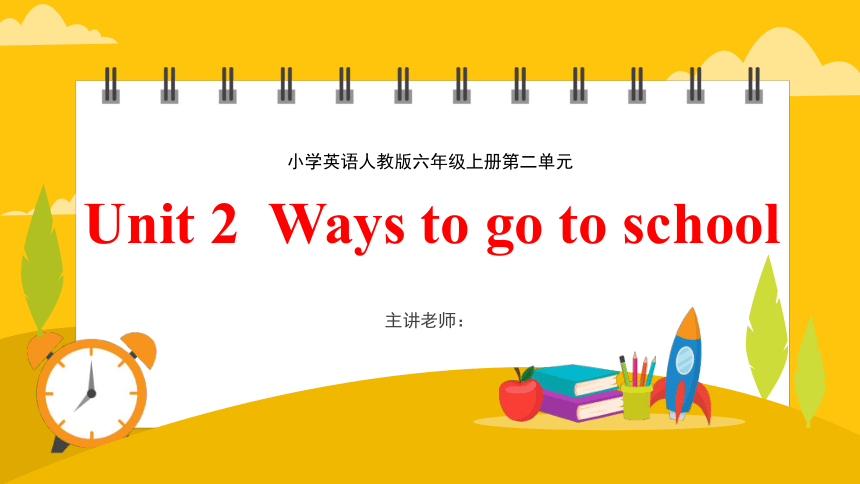 | |
| 格式 | pptx | ||
| 文件大小 | 2.2MB | ||
| 资源类型 | 试卷 | ||
| 版本资源 | 人教版(PEP) | ||
| 科目 | 英语 | ||
| 更新时间 | 2024-08-21 13:56:42 | ||
图片预览

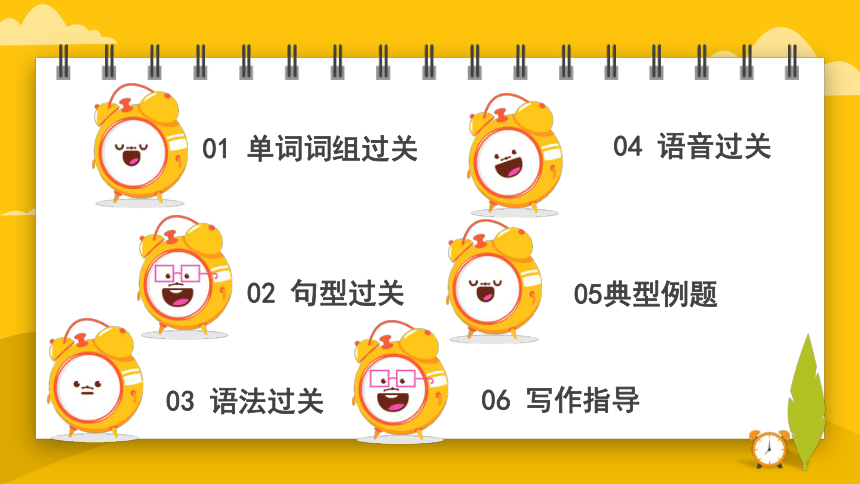

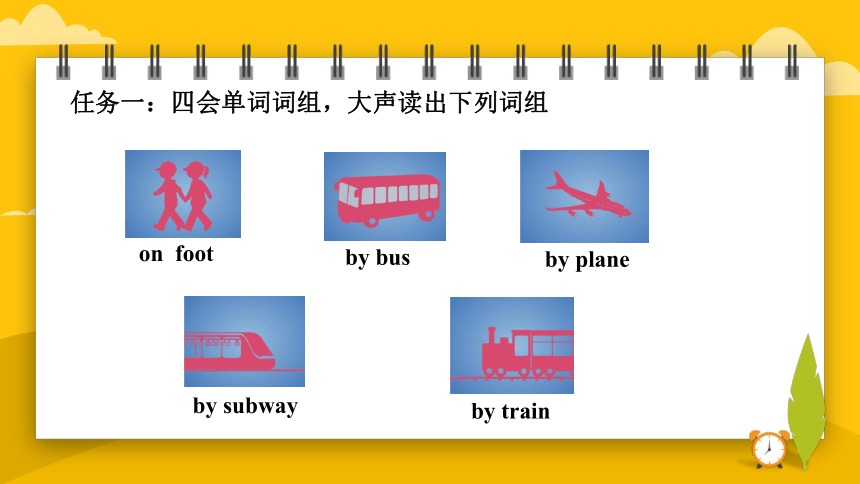
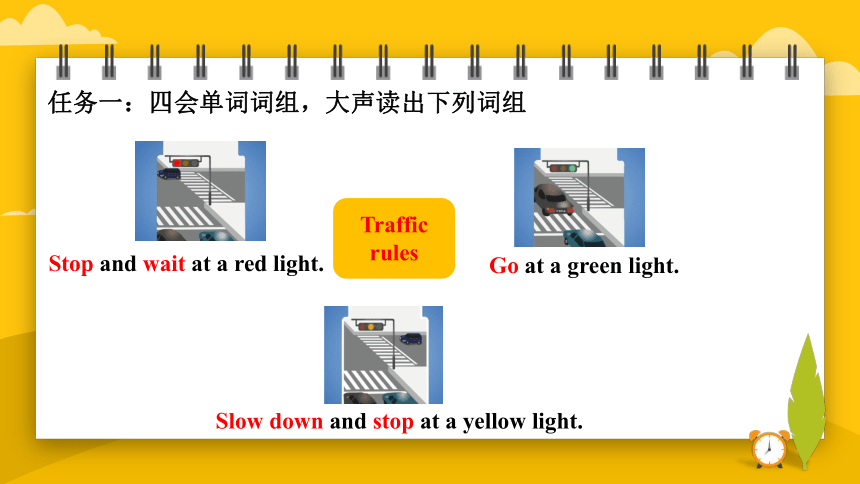
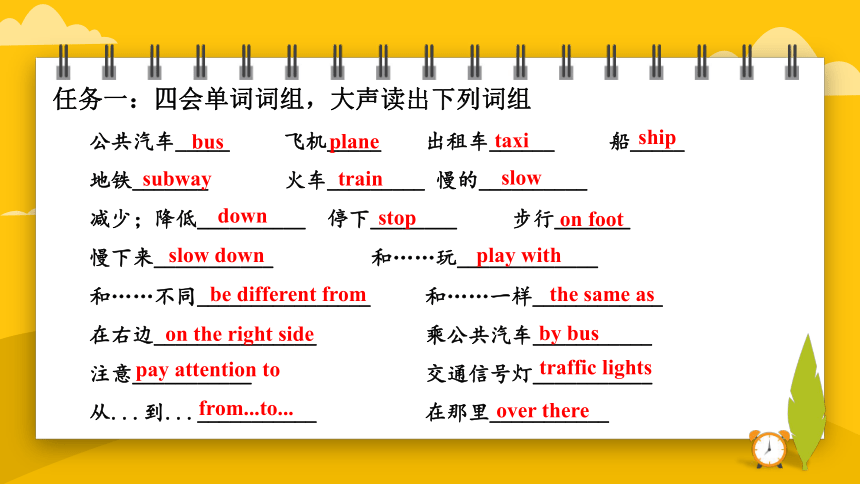
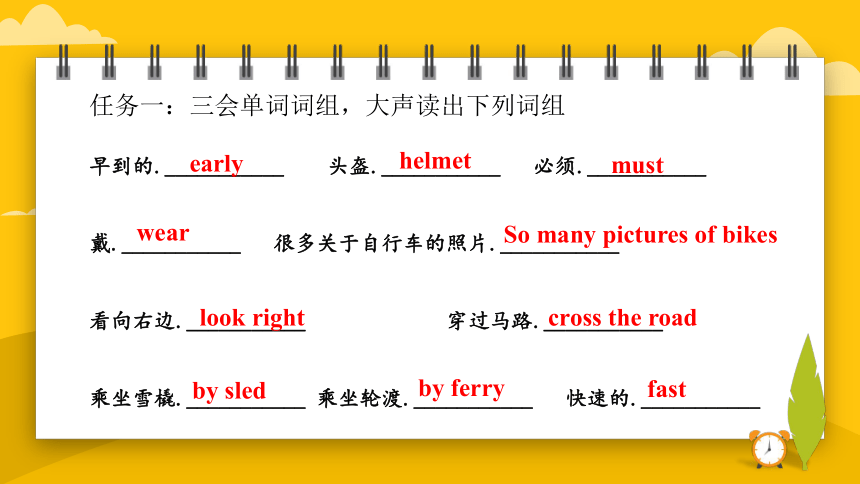
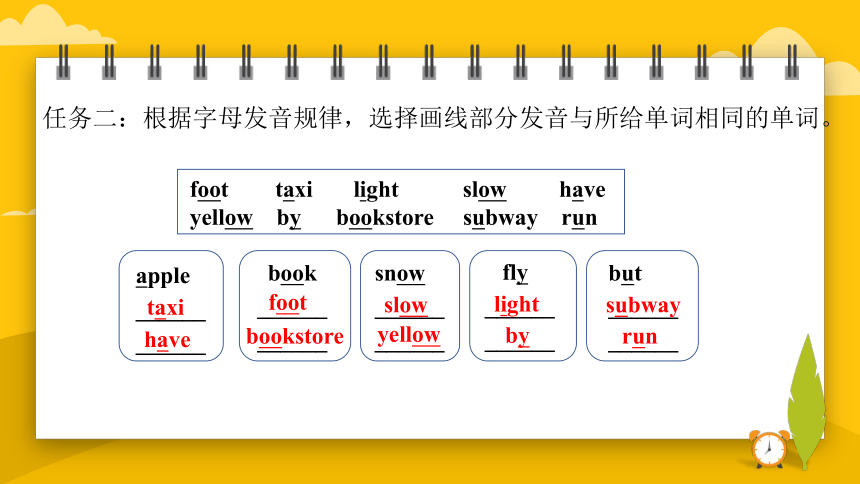


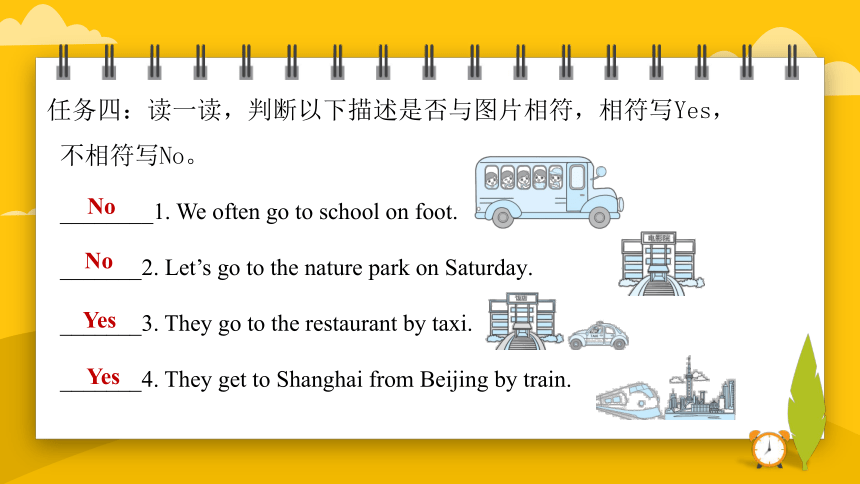
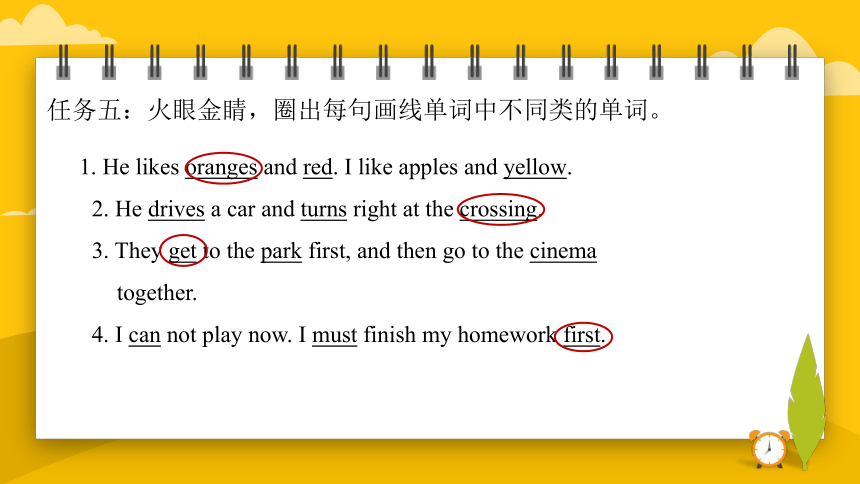
文档简介
(共86张PPT)
Unit 2 Ways to go to school
主讲老师:
小学英语人教版六年级上册第二单元
01 单词词组过关
02 句型过关
03 语法过关
04 语音过关
05典型例题
06 写作指导
单词词组过关
第一部分
任务一:四会单词词组,大声读出下列词组
on foot
by bus
by plane
by subway
by train
Slow down and stop at a yellow light.
Stop and wait at a red light.
Go at a green light.
Traffic rules
任务一:四会单词词组,大声读出下列词组
任务一:四会单词词组,大声读出下列词组
公共汽车_____ 飞机_____ 出租车______ 船_____
地铁_______ 火车_________ 慢的__________
减少;降低__________ 停下________ 步行_______
慢下来___________ 和……玩_____________
和……不同________________ 和……一样____________
在右边_______________ 乘公共汽车___________
注意___________ 交通信号灯___________
从...到...___________ 在那里___________
bus
plane
taxi
ship
subway
train
slow
down
stop
on foot
slow down
play with
be different from
the same as
on the right side
by bus
pay attention to
traffic lights
from...to...
over there
任务一:三会单词词组,大声读出下列词组
早到的.___________ 头盔.___________ 必须.___________
戴.___________ 很多关于自行车的照片.___________
看向右边.___________ 穿过马路.___________
乘坐雪橇.___________ 乘坐轮渡.___________ 快速的.___________
early
helmet
must
wear
So many pictures of bikes
look right
cross the road
by sled
by ferry
fast
任务二:根据字母发音规律,选择画线部分发音与所给单词相同的单词。
foot taxi light slow have
yellow by bookstore subway run
apple
____________
book
____________
snow
______
______
fly
____________
but
____________
foot
taxi
have
bookstore
slow
yellow
light
by
subway
run
任务三:找出与所给单词同类的一项。
( ) 1. plane
A. crossing B. cinema C. subway
( ) 2. by
A. wait B. on C. stop
( ) 3. bookstore
A. museum B. ship C. foot
( ) 4. left
A. under B. right C. in
( ) 5. light
A. fan B. straight C. ferry
C
B
A
B
B
任务三:根据图片补全单词。
1. Look, this is a________. It’s fast.
2. The ________ on the water is very big.
3. The ________ looks like a train. It often goes under the ground.
4. The ________ is coming. We can take it to school.
plane
ship
bus
subway
任务四:读一读,判断以下描述是否与图片相符,相符写Yes,
不相符写No。
________1. We often go to school on foot.
_______2. Let’s go to the nature park on Saturday.
_______3. They go to the restaurant by taxi.
_______4. They get to Shanghai from Beijing by train.
No
No
Yes
Yes
任务五:火眼金睛,圈出每句画线单词中不同类的单词。
1. He likes oranges and red. I like apples and yellow.
2. He drives a car and turns right at the crossing.
3. They get to the park first, and then go to the cinema together.
4. I can not play now. I must finish my homework first.
任务六:观察下面交通警察的手势,并根据其含义写出单词,补全句子。
1. The light is________. Please________.
green go
点拨:这个手势是通行手势,所以灯应该是绿色,并给出通行信号。
2. The light is________. Please________.
点拨:这个手势是禁止通行的手势,对应的信号灯应该是红色。
red stop
3. The light is_______. Please ______ ______ and ______.
yellow slow down stop
点拨:这个手势是慢行等待的手势,对应的信号灯应该为黄色。
4. You can’t go now. But you can________ ______.
点拨:这是右转手势。在很多路口,红灯时虽不能直行,但可以右转。
turn right
任务七:读一读,在句中圈出与所给单词同类的一项。
1. early That’s good for you.
2. sometimes I usually walk to work.
3. bus Do you have a car
4. get How do you go to school
5. Mrs That woman is Miss Wang.
任务八:读一读,判断下列单词中画线部分的发音是(T)否(F)相同。
( ) 1. A. slow B. down C. yellow
( ) 2. A. red B. ferry C. sled
( ) 3. A. bike B. light C. this
( ) 4. A. come B. must C. cousin
( ) 5. A. can B. take C. traffic
F
T
F
T
F
任务九:根据图片及所给首字母,补全单词,完成句子。
1. S______ and w_____ at a red light.
2. Turn l____ at the bookstore.
3. Many students go to school by b_____.
4. Go s_______ and you can find the shop.
top
ait
eft
us
traight
句型过关
第二部分
任务一:重点句型复习。
Don’t go at the red light.
红灯处不要行走。
2. You must pay attention to the traffic lights.
你必须注意交通灯。
3. How do you go to school
你/你们怎么去上学
4.Usually,I come on foot. 通常我走路来。
5. I often go by subway. 我经常乘地铁去。
6. That’s good exercise. 那是很好的锻炼。
7. How do you get to the USA from China 你怎么从中国到达美国?
8. How can I get to the Fuxing Hospital 我怎样到达福兴医院 ?
9. Take the No.57 bus over there. 去那边乘坐57路公交车。
10.So many pictures of bikes. 这么多自行车的照片。
11.In the USA people on bikes must wear one.
在美国,骑自行车的人们必须戴一个(头盔)。
12. Slow down and stop at a yellow light. 在黄灯处减速停车。
13. Stop and wait at a red light. 红灯处停车等待。
14. Go at a green light. 绿灯时行驶。
15.You must look right before you cross the road.
当你过马路时,你必须看向右边
16.Don‘t touch the door. 不要触摸门。
任务二:读一读,根据图片提示,补全句子。(一空一词)
1. —________do you go to________?
— I sometimes ________ to ________by ________.
2. —________will you go to the park
—We will go________ ________.
How
school
go
school
bike
How
by bus
3. —Do you usually ________ to school ______ foot
—Yes, I usually________.
4. —________you usually come ________ bus
—Yes. ____________ I come ________ car.
go
on
walk
Do by
Sometimes by
任务三:选词填空,完成短文。
1. We need to put ________________at this crossing. That’s good for the cars, bikes and people.
2. Look at the__________. I think you need it when you ride a bike on the way.
3. __________please! The bus is coming!
traffic lights
must helmet traffic lights attention wear
helmet
Attention
must helmet traffic lights attention wear
4. We have no time. We __________ finish the work today.
5. You can’t __________ a hat here.
must
wear
There are some different ways to go to school. In Jiangxi,China, some children
go to school 1.________ every day. They must wear a 2.________. In Munich
Germany ,some children go to school 3.________.It's good exercise. However,
they must 4.________ the traffic light. When it's red,they must stop and
5.________.
A. on foot B. life jacket C. wait D. pay attention to E. by ferry
E
B
A
D
C
任务四:读一读,圈出更加符合语境的一项。
1. You can(take by)the No. 30 bus at this bus stop.
2. The light is(red green). Let's go.
3. You(must don’t need to)wear a helmet in China.
4. Look at these people(by on)bikes. They look very happy.
5. Can I(get get to)there on time
任务五:读一读,为下列标识选择正确的描述。
( ) 1. A. Don’t stop here.
B. Stop, please.
A
( ) 2. A. Don’t touch the door.
B. Open the door with your hand.
( ) 3. A. Please run and play here.
B. Pay attention to the children.
A
B
任务五:读一读,为下列标识选择正确的描述。
( )4. A. The traffic lights are red.
B. Pay attention to the traffic lights.
B
任务六:按要求完成下列各题。
1. Go at a red light. (改为否定句)
________________________________________________.
2.He often gets there by subway. (对画线部分提问)
____________________________________________________
Don’t go at a red light.
How does he often get there
点拨:祈使句变否定句,要在句首加Don’t
点拨:1.确定疑问词:划线部分是方式,所以用how来提问
2.借助助动词:he是三单形式,需要借助does
3.助动一出现,动词变原形,gets要变为get
任务六:按要求完成下列各题。
3. He usually walks to the nature park. (写出同义句)
__________________________
4. Amy comes to school by bus. (改为一般疑问句)
____________________________________________________
He usually goes to the nature park on foot.
Does Amy come to school by bus
点拨:walk的同义词是on foot,但on foot 要放在句尾。
点拨:1.含有实义动词的陈述句变一般疑问句要借助助动词do/does
2.Amy 是第三人称单数,要借助does
3.助动一出现,动词变原形,comes要变为come
任务六:按要求完成下列各题。
5. There are three traffic lights in every country. (对画线部分提问)
_______________________________________________
How many traffic lights are there in every country
点拨:1.确定疑问词:划线部分是数字,用How many 提问
2.将句中be词提前,are提前
3.其他照抄,句尾加?
任务七:补全对话。
Amy: Hello, Tom !
Tom: Hi, Amy ! 1.____________
Amy: OK. 2.____________
Tom: Yes, I do. Stop and wait at a red light.
Slow down and stop at a yellow light. And…
Amy: 3.____________
Tom: You are right. Look ! 4.____________ Let's cross the road !
Amy: OK. 5.____________
Tom: Usually I go to school on foot. Sometimes I go to school by subway.
Amy: Look ! The bus is coming. Bye.
Tom: Bye.
A. How do you go to school
B. Let's go home.
C. It's a green light.
D. Do you know the traffic lights
E. Go at a green light.
B
D
E
C
A
任务八:连词成句。
1. how, to, you, come, do, school ( )
_________________________________________
2. sometimes, come, by, I, bike (.)
_________________________________________
3.we, slow, stop, at, down, and, a, yellow, must, light(.)
_________________________________________
4. you, can, bus, over, take, the, No.21, there (.)
________________________________________
How do you come to school ?
Sometimes I / I sometimes come by bike.
We must slow down and stop at a yellow light.
You can take the No.21 bus over there.
任务九:读一读,为问句选答语。
( ) 1. Where is the bus stop
( ) 2. Is there a pet hospital here
( ) 3. How can I get to the cinema
( ) 4. Can I take a bus
( ) 5. How do you go to Beijing
By train. B. Yes, you can. C. Yes, there is.
D. You can walk there. E. It’s next to the bank.
E
C
D
B
A
语法过关
第三部分
come/go后面接的是地点名词时,需用“to+地点名词”;
后面接副词home, here, there等时,要省略掉介词to,表示“来/去……”。
例句:How do we go home 我们怎样回家?
How does he go there 他怎样到那里?
How does Amy come here Amy怎样来这里?
语法点一:地点副词前不加介词to
1.Can you come ________ by bike
A. here B. to here C. school
2.How can we________?
A. get to there B. get there C. get the hospital
典型例题:
A
B
语法点二:频度副词
频度副词:表示事物发生频率的词。
频率 频率副词 用法
高 ↓ 低 always 意为“总是”,发生频率为100%。
usually 意为“通常;一般”,发生频率为80%。
often 意为“经常”,发生频率为60%。
sometimes 意为“有时”,发生频率为40%。
never 意为“从不”,发生频率为0%。
例句:
I often do my homework in the evening. 我经常晚上做作业。
Peter is never late for school.彼得上学从不迟到。
Sometimes, we go to the bookstore on foot.有时,我们步行去书店。
易错点
提示
频度副词在句子中一般位于实义动词之前,be动词、助动词或情态动词之后。但有时候也放在句首用来强调频率。
根据发生的频率为下列单词点亮星星,最多的5颗,最少的1颗。
never
always
often
sometimes
usually
1.My home is near my school. So I ________ go to school on foot.
A.usually B.sometimes C.never
2.We always stay at home.(改为否定句)
We ________ stay at home.
典型例题:
A
never
点拨:always表示“总是”,反义词应该是“从来不”。
3.We ________ go to school by bike. __________ we walk.
A. always; Often B. usually; Sometimes C. usually; Often
4.I often come to school by bike. ________I come________foot.
A. Usually; on B. Sometimes; on C. Often; by
典型例题:
B
B
语法点三:on foot 与walk
交通方式一般用介词by+交通工具。但on foot这一词组中,介词必须用on。
同义转换:go to+地点+on foot=walk to+地点
例句:I go to the park on foot.=I walk to the park.
我步行去公园。
语法点四:take的用法
考点1:take是动词,可以表示“乘坐”,通常用“take a/the+交通工具”来表达交通方式。
考点2:by是介词,通常用“by+交通工具”来表达,交通工具前不加任何冠词。
考点3:take a bus to+某地=go to+某地+by bus
例句:I take a bus to school.=I go to school by bus.
1.Do you often ________ bus to work
A. by B. take C. take a
2.Let's ________a bus________.
A. take; home B. by; home C. take; to home
典型例题:
C
A
语法点五:祈使句
定义:表示命令,请求,要求,警告的句子叫做祈使句。
类型:V型,L型, D型,B型,N型
1.V型:动词原形+其他. Open the door. 打开门。
2.L型:Let+人+动词原形+其他.Let Tom go home now.
让Tom现在回家。
语法点五:祈使句
3.B型:Be 动词+其他 Be quite! 安静
4.D型:“Don’t +动词原形+...” 祈使句的否定形式
Don’t open the door, please. 请不要打开门。
5.N型:No+名词或动词的-ing 形式!
No swimming!禁止游泳!
1.Don't ________ your child run on the bus.
A. letting B. let C. lets
2.Don't ______ the road at the red light.
A. cross B. crossing C. across
3.Take the No.56 bus over there.(变为否定句)
_____________________________________
典型例题:
B
A
Don't take the No.56 bus over there.
语法点六:情态动词
情态动词(Modal verbs)的含义:
情态动词是一种表示语气的单词,用来丰富说话人对这一动作或状态的看法和情感。不能单独做谓语,总是用在动词原形之前。
情态动词有can (could), may (might), must, have to, shall (should), will (would), need (needed),等
语法点六:情态动词
情态动词的主要形式:
can
1.表示能力:Can you play football
We can’t go to the zoo today.
2.表示允许:Can I go outside now
may 表示允许:May I see it
语法点六:情态动词
must
1.表必须:We must cross the road.
2.表示猜测:He must be tall and strong.
should 表示应该:
We should always remember: “Learning by doing.”
He should see a doctor.
语法点六:情态动词
句型转换
1. I can speak English.
变为一般疑问句:__________________________
变为否定句:__________________________
对划线处提问:__________________________
Can you speak English
I can't speak English.
What can you do
语法点六:情态动词
2. He will go to the USA next year.
变为一般疑问句:__________________________
变为否定句:______________________________
对划线处提问:__________________________
Will he go to the USA next year
He will not go to the USA next year.
When will he go to the USA
语法点六:情态动词
3. We will have an English party this Sunday.
变为否定句:
_______________________________________
对划线处提问:
_______________________________________
We will not have an English party this Sunday.
What will you do this Sunday
语法点六:情态动词
4. My friend can jump high.
变为否定句:
_______________________________________
对划线处提问:
_______________________________________
My friend can not jump high.
Whose friend can jump high
语法点六:情态动词
总结:
情态动词要记牢,动词原型来跟梢,
不分人称和数量, 不同情感要看好。
Can表能力和许可,也许、可能may来,
表一定必须must,should应该来报道。
否定变化也不难,情态后把not添。
疑问变化往前跑,Must回答要记好。
语法点七:陈述句变一般疑问句的方法
步骤
1.有情用情,有be用be,一提二改三问号
一提:句中含有be 动词或情态动词,将be 动词或情态动词提前
二改:I,we变为you my,our 变为your,am变为are,some 变any
and 变 or
三问号:句尾加?
语法点七:陈述句变一般疑问句的方法
例题:
1.I am a teacher.(变为一般疑问句)
________ ________ a teacher
肯定回答:____________________
否定回答:____________________
Are
you
Yes,I am.
No,I am not.
语法点七:陈述句变一般疑问句的方法
例题:
2.He can swim.(变为一般疑问句并做肯定与否定回答)
________ ________ swim
肯定回答:____________________
否定回答:____________________
Can
he
Yes,he can.
No,he can’t.
语法点七:陈述句变一般疑问句的方法
2.无情无be找求助,助动一出现,动词变原形
找求助:当句子中没有be动词也没有情态动词时,要借助助动词do/does/did (过去式)
主语是第一人称或复数:借助do,
主语是第三人称单数:借助does
助动一出现,动词变原形:原句中的动词恢复原形
语法点七:陈述句变一般疑问句的方法
例题:
1.I usually go to school by bike. (变为一般疑问句,并做肯定和否定回答)
________ ________ ________ go to school by bike?
肯定回答:____________________
否定回答:____________________
Do
you
Yes,I do.
No,I don’t.
usually
语法点七:陈述句变一般疑问句的方法
例题:
1.He usually goes to school by bike. (变为一般疑问句,并做肯定和否定回答)
________ ________ ________ ________ to school by bike?
肯定回答:____________________
否定回答:____________________
Does
he
Yes,he does.
No,he doesn’t.
usually
go
语法点七:陈述句变一般疑问句的方法
练习:将下列句子变为一般疑问句并做肯定否定回答
1.She goes to hospital by car.
_______________________________________
_______________________________________
Does she go to hospital by car
Yes, she does.\ No, she doesn’t.
点拨:看句中没有be动词或情态动词,决定句前加Do或Does,再看主语是she,所以句前加Does, 动词goes还原为go。
语法点七:陈述句变一般疑问句的方法
练习:将下列句子变为一般疑问句并做肯定否定回答
2.He is playing a game.
_______________________________________
_______________________________________
点拨:句中有be动词,直接提前
Is he playing a game
Yes, he is.\ No, he isn’t.
语法点七:陈述句变一般疑问句的方法
练习:将下列句子变为一般疑问句并做肯定否定回答
3. I can fly kites.
_______________________________________
_______________________________________
点拨:句中有情态动词,直接提前,I 变为you
Can you fly kites
Yes, I can.\ No, I can’t.
语音过关
第四部分
英语句子中连读的运用
在同一个意群(意思密切相关的一组词)中,如果前一个词的读音以辅音结尾,后一个词的读音以元音开头,前边的辅音和后边的元音可以连起来读,这种现象叫连读。用符号“ ︶ ”表示。连读所构成的音节一般不重读。
英语句子中连读的运用
易错点
提示
如果句中的短语之间或句子之间有停顿,则其相邻的音不连读。
例句:Put it on. 穿上它。
I want a cup of tea. 我想要一杯茶。 This is a coat. 这是一件外套。
︶
︶
︶
︶
︶
︶
英语句子中连读的运用
争做“朗读小明星”:读一读,标出正确的连读。
(1) Look at it.
(2) Not at all.
(3) It isn't a pen.
︶
︶
︶
︶
︶
︶
典型例题
第五部分
( )1.You can cross the road ________ a green light.
A. at B. on C. of
( )2. The subway is very ________, but the bike is very slow.
A. good B. fast C. slow
( )3. Don't ________ your child run on the bus.
A. letting B. let C. lets
( )4.We ________ go to school by bike. __________ we walk.
A. always; Often B. usually; Sometimes C. usually; Often
一.单项选择
A
B
B
B
( )5. In Alaska, USA, it snows a lot. Some kids go to school________.
A. by ferry B. by sled C. by ship
( ) 6. He must ________attention ________the traffic lights.
A. pays; with B. pay; to C. paying; to
( ) 7. In Hong Kong, people drive ________the ________side.
A. on; left B. on; right C. at; left
( ) 8. Let's ________a bus________.
A. take; home B. by; home C. take; to home
B
B
A
A
( ) 9. Munich is a city in________.
A. Alaska B. the UK C. Germany
( ) 10. I often come to school by bike. ________I come________foot.
A. Usually; on B. Sometimes; on C. Often; by
( ) 11. ________the USA people ________bikes must wear a helmet.
A. In; on B. On; in C. In; by
( ) 12. I usually________. That's good exercise.
A. walk to school B. come to school by carC. come to school with my mum
C
B
A
A
( ) 13. You must________ at a ________light.
A. go; yellow B. go slowly; red C. stop; red
( ) 14. Look, it means________.
A. you can go straight and turn left here
B. you can go straight and turn right here
C. you can't go straight or turn right here
( ) 15. How can we________?
A. get to there B. get there C. get the hospital
C
B
B
( ) 16. —______ do you go to school
— I go to school ______ bike.
A. How ; by B. What ; by C. How ,on
( ) 17. My uncle goes to Australia ______. He flies there.
A. by bus B. by train C.by plane
( ) 18. Don’t _______at the red light.
A. wait B. go C. going
( ) 19. In England, drivers drive on the ______.
A. both sides B. left side C. right side
A
C
B
B
( )1. People drive on the right side in China and in the UK. ( )2.In China, you must look left first before you cross the road.
( )3. You must look right before you cross the road in Hong Kong.
( )4. Don't wear a life jacket by ferry. ( )5.People on bikes must wear a helmet in the USA.
( )6.You can stop and wait at a green light.
二.判断对错
F
T
T
F
T
F
写作指导
第五部分
四步法写交通方式
题目:以“How do I go to school ”为题,写一写自己去学校的交通方式。
四步法用于介绍自己去学校的交通方式
第一步: 审题、抓取关键词:去学校;交通方式
第二步: 罗列重要信息:介绍自己家离学校的远近、去学校的一些交通方式以及频度副词的运用
第三步: 知识储备:
1.常用的频度副词:usually 通常, often 经常, sometimes 有时
2.常见的交通方式:on foot 步行, by bike 骑自行车,by bus 乘公共车,
by train 乘火车,by subway 乘地铁, by ship 坐船
3.常用的句型: My home is ... the school. 我的家……学校。
Usually/Sometimes I go to school... 通常/有时我……去学校。
I often go to school... 我经常……去学校。
第四步:连词成句,连句成篇。
How do I go to school①
Hi, everyone. My home is near my school. So I usually go to school on foot . Sometimes I go to school by bike. But I never take the train or subway③ to school. I will take my father’s car to school when it rains. What about you Please tell me.
范文:
小练笔:
写一写你和家人是怎样去上学或上班的。
要求:1. 语句通顺,书写工整。
2. 不少于50个单词。
Hi, I’m Tina. There are three people in my family. I’m a student in No.1 School. My home is near my school. So I go to school by bike every day. My father teaches English in my school. He goes to school on foot. He thinks walking is a good way to exercise.
参考例文:
My mother is a doctor. Her hospital is far from our home. She usually goes to work by bus. We all pay attention to the traffic lights. Slow down and stop at a yellow light. Stop and wait at a red light. Go at a green light.
Thank you!
Unit 2 Ways to go to school
主讲老师:
小学英语人教版六年级上册第二单元
01 单词词组过关
02 句型过关
03 语法过关
04 语音过关
05典型例题
06 写作指导
单词词组过关
第一部分
任务一:四会单词词组,大声读出下列词组
on foot
by bus
by plane
by subway
by train
Slow down and stop at a yellow light.
Stop and wait at a red light.
Go at a green light.
Traffic rules
任务一:四会单词词组,大声读出下列词组
任务一:四会单词词组,大声读出下列词组
公共汽车_____ 飞机_____ 出租车______ 船_____
地铁_______ 火车_________ 慢的__________
减少;降低__________ 停下________ 步行_______
慢下来___________ 和……玩_____________
和……不同________________ 和……一样____________
在右边_______________ 乘公共汽车___________
注意___________ 交通信号灯___________
从...到...___________ 在那里___________
bus
plane
taxi
ship
subway
train
slow
down
stop
on foot
slow down
play with
be different from
the same as
on the right side
by bus
pay attention to
traffic lights
from...to...
over there
任务一:三会单词词组,大声读出下列词组
早到的.___________ 头盔.___________ 必须.___________
戴.___________ 很多关于自行车的照片.___________
看向右边.___________ 穿过马路.___________
乘坐雪橇.___________ 乘坐轮渡.___________ 快速的.___________
early
helmet
must
wear
So many pictures of bikes
look right
cross the road
by sled
by ferry
fast
任务二:根据字母发音规律,选择画线部分发音与所给单词相同的单词。
foot taxi light slow have
yellow by bookstore subway run
apple
____________
book
____________
snow
______
______
fly
____________
but
____________
foot
taxi
have
bookstore
slow
yellow
light
by
subway
run
任务三:找出与所给单词同类的一项。
( ) 1. plane
A. crossing B. cinema C. subway
( ) 2. by
A. wait B. on C. stop
( ) 3. bookstore
A. museum B. ship C. foot
( ) 4. left
A. under B. right C. in
( ) 5. light
A. fan B. straight C. ferry
C
B
A
B
B
任务三:根据图片补全单词。
1. Look, this is a________. It’s fast.
2. The ________ on the water is very big.
3. The ________ looks like a train. It often goes under the ground.
4. The ________ is coming. We can take it to school.
plane
ship
bus
subway
任务四:读一读,判断以下描述是否与图片相符,相符写Yes,
不相符写No。
________1. We often go to school on foot.
_______2. Let’s go to the nature park on Saturday.
_______3. They go to the restaurant by taxi.
_______4. They get to Shanghai from Beijing by train.
No
No
Yes
Yes
任务五:火眼金睛,圈出每句画线单词中不同类的单词。
1. He likes oranges and red. I like apples and yellow.
2. He drives a car and turns right at the crossing.
3. They get to the park first, and then go to the cinema together.
4. I can not play now. I must finish my homework first.
任务六:观察下面交通警察的手势,并根据其含义写出单词,补全句子。
1. The light is________. Please________.
green go
点拨:这个手势是通行手势,所以灯应该是绿色,并给出通行信号。
2. The light is________. Please________.
点拨:这个手势是禁止通行的手势,对应的信号灯应该是红色。
red stop
3. The light is_______. Please ______ ______ and ______.
yellow slow down stop
点拨:这个手势是慢行等待的手势,对应的信号灯应该为黄色。
4. You can’t go now. But you can________ ______.
点拨:这是右转手势。在很多路口,红灯时虽不能直行,但可以右转。
turn right
任务七:读一读,在句中圈出与所给单词同类的一项。
1. early That’s good for you.
2. sometimes I usually walk to work.
3. bus Do you have a car
4. get How do you go to school
5. Mrs That woman is Miss Wang.
任务八:读一读,判断下列单词中画线部分的发音是(T)否(F)相同。
( ) 1. A. slow B. down C. yellow
( ) 2. A. red B. ferry C. sled
( ) 3. A. bike B. light C. this
( ) 4. A. come B. must C. cousin
( ) 5. A. can B. take C. traffic
F
T
F
T
F
任务九:根据图片及所给首字母,补全单词,完成句子。
1. S______ and w_____ at a red light.
2. Turn l____ at the bookstore.
3. Many students go to school by b_____.
4. Go s_______ and you can find the shop.
top
ait
eft
us
traight
句型过关
第二部分
任务一:重点句型复习。
Don’t go at the red light.
红灯处不要行走。
2. You must pay attention to the traffic lights.
你必须注意交通灯。
3. How do you go to school
你/你们怎么去上学
4.Usually,I come on foot. 通常我走路来。
5. I often go by subway. 我经常乘地铁去。
6. That’s good exercise. 那是很好的锻炼。
7. How do you get to the USA from China 你怎么从中国到达美国?
8. How can I get to the Fuxing Hospital 我怎样到达福兴医院 ?
9. Take the No.57 bus over there. 去那边乘坐57路公交车。
10.So many pictures of bikes. 这么多自行车的照片。
11.In the USA people on bikes must wear one.
在美国,骑自行车的人们必须戴一个(头盔)。
12. Slow down and stop at a yellow light. 在黄灯处减速停车。
13. Stop and wait at a red light. 红灯处停车等待。
14. Go at a green light. 绿灯时行驶。
15.You must look right before you cross the road.
当你过马路时,你必须看向右边
16.Don‘t touch the door. 不要触摸门。
任务二:读一读,根据图片提示,补全句子。(一空一词)
1. —________do you go to________?
— I sometimes ________ to ________by ________.
2. —________will you go to the park
—We will go________ ________.
How
school
go
school
bike
How
by bus
3. —Do you usually ________ to school ______ foot
—Yes, I usually________.
4. —________you usually come ________ bus
—Yes. ____________ I come ________ car.
go
on
walk
Do by
Sometimes by
任务三:选词填空,完成短文。
1. We need to put ________________at this crossing. That’s good for the cars, bikes and people.
2. Look at the__________. I think you need it when you ride a bike on the way.
3. __________please! The bus is coming!
traffic lights
must helmet traffic lights attention wear
helmet
Attention
must helmet traffic lights attention wear
4. We have no time. We __________ finish the work today.
5. You can’t __________ a hat here.
must
wear
There are some different ways to go to school. In Jiangxi,China, some children
go to school 1.________ every day. They must wear a 2.________. In Munich
Germany ,some children go to school 3.________.It's good exercise. However,
they must 4.________ the traffic light. When it's red,they must stop and
5.________.
A. on foot B. life jacket C. wait D. pay attention to E. by ferry
E
B
A
D
C
任务四:读一读,圈出更加符合语境的一项。
1. You can(take by)the No. 30 bus at this bus stop.
2. The light is(red green). Let's go.
3. You(must don’t need to)wear a helmet in China.
4. Look at these people(by on)bikes. They look very happy.
5. Can I(get get to)there on time
任务五:读一读,为下列标识选择正确的描述。
( ) 1. A. Don’t stop here.
B. Stop, please.
A
( ) 2. A. Don’t touch the door.
B. Open the door with your hand.
( ) 3. A. Please run and play here.
B. Pay attention to the children.
A
B
任务五:读一读,为下列标识选择正确的描述。
( )4. A. The traffic lights are red.
B. Pay attention to the traffic lights.
B
任务六:按要求完成下列各题。
1. Go at a red light. (改为否定句)
________________________________________________.
2.He often gets there by subway. (对画线部分提问)
____________________________________________________
Don’t go at a red light.
How does he often get there
点拨:祈使句变否定句,要在句首加Don’t
点拨:1.确定疑问词:划线部分是方式,所以用how来提问
2.借助助动词:he是三单形式,需要借助does
3.助动一出现,动词变原形,gets要变为get
任务六:按要求完成下列各题。
3. He usually walks to the nature park. (写出同义句)
__________________________
4. Amy comes to school by bus. (改为一般疑问句)
____________________________________________________
He usually goes to the nature park on foot.
Does Amy come to school by bus
点拨:walk的同义词是on foot,但on foot 要放在句尾。
点拨:1.含有实义动词的陈述句变一般疑问句要借助助动词do/does
2.Amy 是第三人称单数,要借助does
3.助动一出现,动词变原形,comes要变为come
任务六:按要求完成下列各题。
5. There are three traffic lights in every country. (对画线部分提问)
_______________________________________________
How many traffic lights are there in every country
点拨:1.确定疑问词:划线部分是数字,用How many 提问
2.将句中be词提前,are提前
3.其他照抄,句尾加?
任务七:补全对话。
Amy: Hello, Tom !
Tom: Hi, Amy ! 1.____________
Amy: OK. 2.____________
Tom: Yes, I do. Stop and wait at a red light.
Slow down and stop at a yellow light. And…
Amy: 3.____________
Tom: You are right. Look ! 4.____________ Let's cross the road !
Amy: OK. 5.____________
Tom: Usually I go to school on foot. Sometimes I go to school by subway.
Amy: Look ! The bus is coming. Bye.
Tom: Bye.
A. How do you go to school
B. Let's go home.
C. It's a green light.
D. Do you know the traffic lights
E. Go at a green light.
B
D
E
C
A
任务八:连词成句。
1. how, to, you, come, do, school ( )
_________________________________________
2. sometimes, come, by, I, bike (.)
_________________________________________
3.we, slow, stop, at, down, and, a, yellow, must, light(.)
_________________________________________
4. you, can, bus, over, take, the, No.21, there (.)
________________________________________
How do you come to school ?
Sometimes I / I sometimes come by bike.
We must slow down and stop at a yellow light.
You can take the No.21 bus over there.
任务九:读一读,为问句选答语。
( ) 1. Where is the bus stop
( ) 2. Is there a pet hospital here
( ) 3. How can I get to the cinema
( ) 4. Can I take a bus
( ) 5. How do you go to Beijing
By train. B. Yes, you can. C. Yes, there is.
D. You can walk there. E. It’s next to the bank.
E
C
D
B
A
语法过关
第三部分
come/go后面接的是地点名词时,需用“to+地点名词”;
后面接副词home, here, there等时,要省略掉介词to,表示“来/去……”。
例句:How do we go home 我们怎样回家?
How does he go there 他怎样到那里?
How does Amy come here Amy怎样来这里?
语法点一:地点副词前不加介词to
1.Can you come ________ by bike
A. here B. to here C. school
2.How can we________?
A. get to there B. get there C. get the hospital
典型例题:
A
B
语法点二:频度副词
频度副词:表示事物发生频率的词。
频率 频率副词 用法
高 ↓ 低 always 意为“总是”,发生频率为100%。
usually 意为“通常;一般”,发生频率为80%。
often 意为“经常”,发生频率为60%。
sometimes 意为“有时”,发生频率为40%。
never 意为“从不”,发生频率为0%。
例句:
I often do my homework in the evening. 我经常晚上做作业。
Peter is never late for school.彼得上学从不迟到。
Sometimes, we go to the bookstore on foot.有时,我们步行去书店。
易错点
提示
频度副词在句子中一般位于实义动词之前,be动词、助动词或情态动词之后。但有时候也放在句首用来强调频率。
根据发生的频率为下列单词点亮星星,最多的5颗,最少的1颗。
never
always
often
sometimes
usually
1.My home is near my school. So I ________ go to school on foot.
A.usually B.sometimes C.never
2.We always stay at home.(改为否定句)
We ________ stay at home.
典型例题:
A
never
点拨:always表示“总是”,反义词应该是“从来不”。
3.We ________ go to school by bike. __________ we walk.
A. always; Often B. usually; Sometimes C. usually; Often
4.I often come to school by bike. ________I come________foot.
A. Usually; on B. Sometimes; on C. Often; by
典型例题:
B
B
语法点三:on foot 与walk
交通方式一般用介词by+交通工具。但on foot这一词组中,介词必须用on。
同义转换:go to+地点+on foot=walk to+地点
例句:I go to the park on foot.=I walk to the park.
我步行去公园。
语法点四:take的用法
考点1:take是动词,可以表示“乘坐”,通常用“take a/the+交通工具”来表达交通方式。
考点2:by是介词,通常用“by+交通工具”来表达,交通工具前不加任何冠词。
考点3:take a bus to+某地=go to+某地+by bus
例句:I take a bus to school.=I go to school by bus.
1.Do you often ________ bus to work
A. by B. take C. take a
2.Let's ________a bus________.
A. take; home B. by; home C. take; to home
典型例题:
C
A
语法点五:祈使句
定义:表示命令,请求,要求,警告的句子叫做祈使句。
类型:V型,L型, D型,B型,N型
1.V型:动词原形+其他. Open the door. 打开门。
2.L型:Let+人+动词原形+其他.Let Tom go home now.
让Tom现在回家。
语法点五:祈使句
3.B型:Be 动词+其他 Be quite! 安静
4.D型:“Don’t +动词原形+...” 祈使句的否定形式
Don’t open the door, please. 请不要打开门。
5.N型:No+名词或动词的-ing 形式!
No swimming!禁止游泳!
1.Don't ________ your child run on the bus.
A. letting B. let C. lets
2.Don't ______ the road at the red light.
A. cross B. crossing C. across
3.Take the No.56 bus over there.(变为否定句)
_____________________________________
典型例题:
B
A
Don't take the No.56 bus over there.
语法点六:情态动词
情态动词(Modal verbs)的含义:
情态动词是一种表示语气的单词,用来丰富说话人对这一动作或状态的看法和情感。不能单独做谓语,总是用在动词原形之前。
情态动词有can (could), may (might), must, have to, shall (should), will (would), need (needed),等
语法点六:情态动词
情态动词的主要形式:
can
1.表示能力:Can you play football
We can’t go to the zoo today.
2.表示允许:Can I go outside now
may 表示允许:May I see it
语法点六:情态动词
must
1.表必须:We must cross the road.
2.表示猜测:He must be tall and strong.
should 表示应该:
We should always remember: “Learning by doing.”
He should see a doctor.
语法点六:情态动词
句型转换
1. I can speak English.
变为一般疑问句:__________________________
变为否定句:__________________________
对划线处提问:__________________________
Can you speak English
I can't speak English.
What can you do
语法点六:情态动词
2. He will go to the USA next year.
变为一般疑问句:__________________________
变为否定句:______________________________
对划线处提问:__________________________
Will he go to the USA next year
He will not go to the USA next year.
When will he go to the USA
语法点六:情态动词
3. We will have an English party this Sunday.
变为否定句:
_______________________________________
对划线处提问:
_______________________________________
We will not have an English party this Sunday.
What will you do this Sunday
语法点六:情态动词
4. My friend can jump high.
变为否定句:
_______________________________________
对划线处提问:
_______________________________________
My friend can not jump high.
Whose friend can jump high
语法点六:情态动词
总结:
情态动词要记牢,动词原型来跟梢,
不分人称和数量, 不同情感要看好。
Can表能力和许可,也许、可能may来,
表一定必须must,should应该来报道。
否定变化也不难,情态后把not添。
疑问变化往前跑,Must回答要记好。
语法点七:陈述句变一般疑问句的方法
步骤
1.有情用情,有be用be,一提二改三问号
一提:句中含有be 动词或情态动词,将be 动词或情态动词提前
二改:I,we变为you my,our 变为your,am变为are,some 变any
and 变 or
三问号:句尾加?
语法点七:陈述句变一般疑问句的方法
例题:
1.I am a teacher.(变为一般疑问句)
________ ________ a teacher
肯定回答:____________________
否定回答:____________________
Are
you
Yes,I am.
No,I am not.
语法点七:陈述句变一般疑问句的方法
例题:
2.He can swim.(变为一般疑问句并做肯定与否定回答)
________ ________ swim
肯定回答:____________________
否定回答:____________________
Can
he
Yes,he can.
No,he can’t.
语法点七:陈述句变一般疑问句的方法
2.无情无be找求助,助动一出现,动词变原形
找求助:当句子中没有be动词也没有情态动词时,要借助助动词do/does/did (过去式)
主语是第一人称或复数:借助do,
主语是第三人称单数:借助does
助动一出现,动词变原形:原句中的动词恢复原形
语法点七:陈述句变一般疑问句的方法
例题:
1.I usually go to school by bike. (变为一般疑问句,并做肯定和否定回答)
________ ________ ________ go to school by bike?
肯定回答:____________________
否定回答:____________________
Do
you
Yes,I do.
No,I don’t.
usually
语法点七:陈述句变一般疑问句的方法
例题:
1.He usually goes to school by bike. (变为一般疑问句,并做肯定和否定回答)
________ ________ ________ ________ to school by bike?
肯定回答:____________________
否定回答:____________________
Does
he
Yes,he does.
No,he doesn’t.
usually
go
语法点七:陈述句变一般疑问句的方法
练习:将下列句子变为一般疑问句并做肯定否定回答
1.She goes to hospital by car.
_______________________________________
_______________________________________
Does she go to hospital by car
Yes, she does.\ No, she doesn’t.
点拨:看句中没有be动词或情态动词,决定句前加Do或Does,再看主语是she,所以句前加Does, 动词goes还原为go。
语法点七:陈述句变一般疑问句的方法
练习:将下列句子变为一般疑问句并做肯定否定回答
2.He is playing a game.
_______________________________________
_______________________________________
点拨:句中有be动词,直接提前
Is he playing a game
Yes, he is.\ No, he isn’t.
语法点七:陈述句变一般疑问句的方法
练习:将下列句子变为一般疑问句并做肯定否定回答
3. I can fly kites.
_______________________________________
_______________________________________
点拨:句中有情态动词,直接提前,I 变为you
Can you fly kites
Yes, I can.\ No, I can’t.
语音过关
第四部分
英语句子中连读的运用
在同一个意群(意思密切相关的一组词)中,如果前一个词的读音以辅音结尾,后一个词的读音以元音开头,前边的辅音和后边的元音可以连起来读,这种现象叫连读。用符号“ ︶ ”表示。连读所构成的音节一般不重读。
英语句子中连读的运用
易错点
提示
如果句中的短语之间或句子之间有停顿,则其相邻的音不连读。
例句:Put it on. 穿上它。
I want a cup of tea. 我想要一杯茶。 This is a coat. 这是一件外套。
︶
︶
︶
︶
︶
︶
英语句子中连读的运用
争做“朗读小明星”:读一读,标出正确的连读。
(1) Look at it.
(2) Not at all.
(3) It isn't a pen.
︶
︶
︶
︶
︶
︶
典型例题
第五部分
( )1.You can cross the road ________ a green light.
A. at B. on C. of
( )2. The subway is very ________, but the bike is very slow.
A. good B. fast C. slow
( )3. Don't ________ your child run on the bus.
A. letting B. let C. lets
( )4.We ________ go to school by bike. __________ we walk.
A. always; Often B. usually; Sometimes C. usually; Often
一.单项选择
A
B
B
B
( )5. In Alaska, USA, it snows a lot. Some kids go to school________.
A. by ferry B. by sled C. by ship
( ) 6. He must ________attention ________the traffic lights.
A. pays; with B. pay; to C. paying; to
( ) 7. In Hong Kong, people drive ________the ________side.
A. on; left B. on; right C. at; left
( ) 8. Let's ________a bus________.
A. take; home B. by; home C. take; to home
B
B
A
A
( ) 9. Munich is a city in________.
A. Alaska B. the UK C. Germany
( ) 10. I often come to school by bike. ________I come________foot.
A. Usually; on B. Sometimes; on C. Often; by
( ) 11. ________the USA people ________bikes must wear a helmet.
A. In; on B. On; in C. In; by
( ) 12. I usually________. That's good exercise.
A. walk to school B. come to school by carC. come to school with my mum
C
B
A
A
( ) 13. You must________ at a ________light.
A. go; yellow B. go slowly; red C. stop; red
( ) 14. Look, it means________.
A. you can go straight and turn left here
B. you can go straight and turn right here
C. you can't go straight or turn right here
( ) 15. How can we________?
A. get to there B. get there C. get the hospital
C
B
B
( ) 16. —______ do you go to school
— I go to school ______ bike.
A. How ; by B. What ; by C. How ,on
( ) 17. My uncle goes to Australia ______. He flies there.
A. by bus B. by train C.by plane
( ) 18. Don’t _______at the red light.
A. wait B. go C. going
( ) 19. In England, drivers drive on the ______.
A. both sides B. left side C. right side
A
C
B
B
( )1. People drive on the right side in China and in the UK. ( )2.In China, you must look left first before you cross the road.
( )3. You must look right before you cross the road in Hong Kong.
( )4. Don't wear a life jacket by ferry. ( )5.People on bikes must wear a helmet in the USA.
( )6.You can stop and wait at a green light.
二.判断对错
F
T
T
F
T
F
写作指导
第五部分
四步法写交通方式
题目:以“How do I go to school ”为题,写一写自己去学校的交通方式。
四步法用于介绍自己去学校的交通方式
第一步: 审题、抓取关键词:去学校;交通方式
第二步: 罗列重要信息:介绍自己家离学校的远近、去学校的一些交通方式以及频度副词的运用
第三步: 知识储备:
1.常用的频度副词:usually 通常, often 经常, sometimes 有时
2.常见的交通方式:on foot 步行, by bike 骑自行车,by bus 乘公共车,
by train 乘火车,by subway 乘地铁, by ship 坐船
3.常用的句型: My home is ... the school. 我的家……学校。
Usually/Sometimes I go to school... 通常/有时我……去学校。
I often go to school... 我经常……去学校。
第四步:连词成句,连句成篇。
How do I go to school①
Hi, everyone. My home is near my school. So I usually go to school on foot . Sometimes I go to school by bike. But I never take the train or subway③ to school. I will take my father’s car to school when it rains. What about you Please tell me.
范文:
小练笔:
写一写你和家人是怎样去上学或上班的。
要求:1. 语句通顺,书写工整。
2. 不少于50个单词。
Hi, I’m Tina. There are three people in my family. I’m a student in No.1 School. My home is near my school. So I go to school by bike every day. My father teaches English in my school. He goes to school on foot. He thinks walking is a good way to exercise.
参考例文:
My mother is a doctor. Her hospital is far from our home. She usually goes to work by bus. We all pay attention to the traffic lights. Slow down and stop at a yellow light. Stop and wait at a red light. Go at a green light.
Thank you!
同课章节目录
